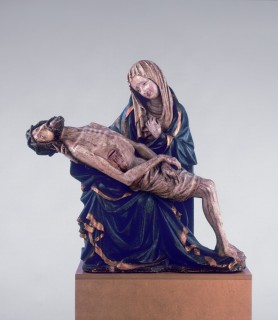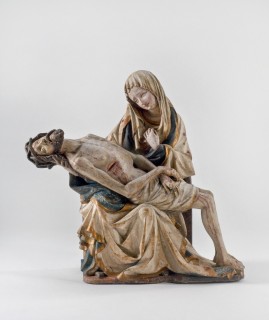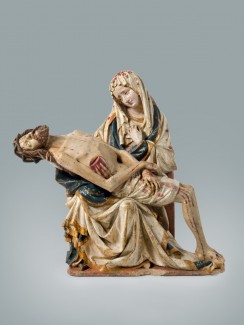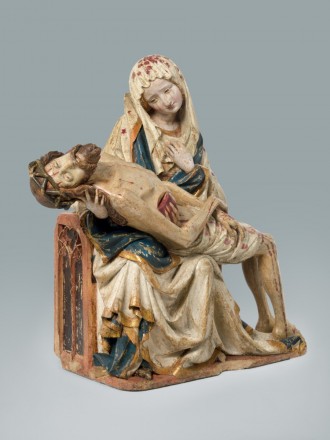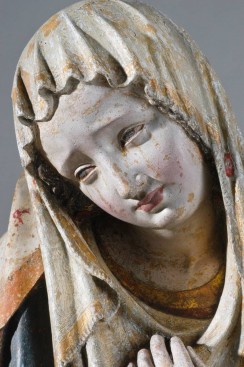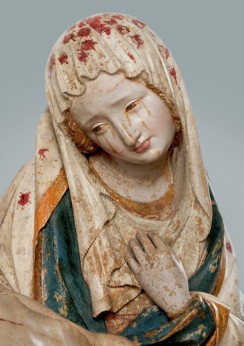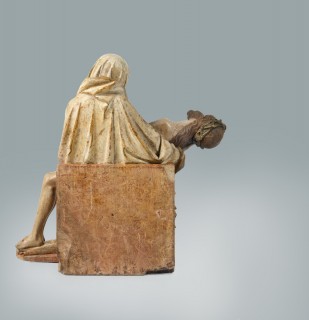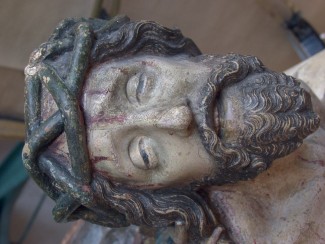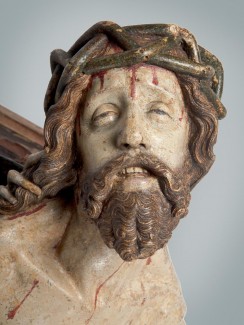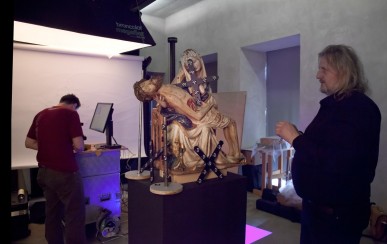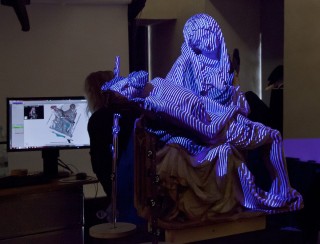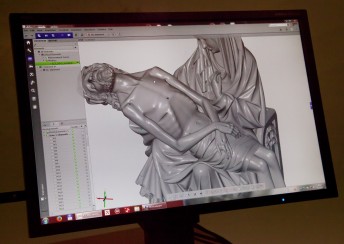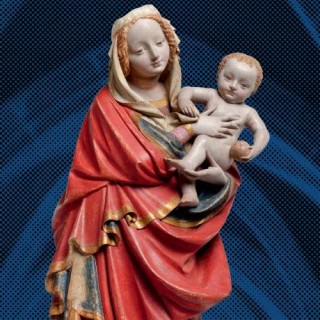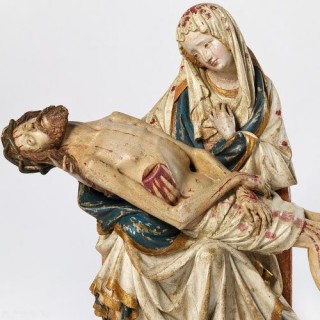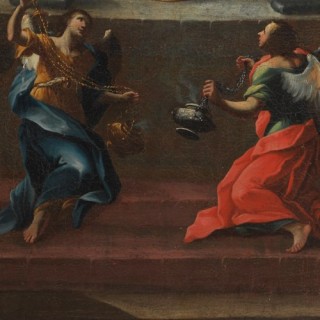Křivák´s Pietà | Restoration
Křivák’s Pietà | Restoration 2005 / 2014–2015
April 23 – October 4 2015
Olomouc Archdiocesan Museum | St. John the Baptist Chapel
Křivák’s Pietà is one of the finest Czech Gothic sculptures representing the art of Beautiful Style. No written records exist regarding its origin and acquisition. Art historians who have studied the Pietà, mostly considered it a work created by Prague or Moravian sculptor for the Cathedral of St. Wenceslas in Olomouc or for some nearby monastery.
Křivák’s Pietà was first restored in 1954 by Karel Kotrba, who removed several layers of overpainting up to the deep blue color of Marys cloak. The next survey was conducted in 1999 by the restorer František Sysel, aimed at elucidating the question of the original polychrome of the artwork. The survey, however, did not lead to unequivocal conclusions, therefore the restoration works were not carried out that time. According to the then analyses it seemed likely that the original color of the was gray-blue.
In 2005, the restoration works on Křivák’s Pietà were undertaken by Radomír Surma. Underneath the existing final layer of Mary’s cloak he found another layer and concluded that its original color was white. Then he proceeded in removing of the newer overpaints to the original polychrome layer, which showed itself to be almost entirely preserved.
After the removal of the last repaints it showed itself out that veil of the Virgin Mary on Křivák’s Pietà was dramatically curtailed in the past. Paradoxically, the removal of the veil revealing the Marys face, despite somewhat degrading the appearances of the sculpture, allowed its comparison with the preserved panel paintings. It is possible to say, that the very face of the Virgin Mary closely resembles the face of Madonna of Roudnice (National Gallery in Prague), painted by Master of Třeboň altar in the 1380s.
It is probable that Olomouc Pietà is one of the first Pietàs depicting the grieving Virgin Mary as a young and beautiful girl, on the contrary to most of the 1380s and 1390s Pietàs which further continued in the „realistic“ tradition of the Parléř workshop depicting the Virgin Mary in her real age, in accordance with the apocryphal texts. In this sense, the distinction between the Pietà and beautiful Madonna is completely blurred in the case of the Křivák’s Pietà.
The analysis of marlstone of which the statue is made indicated the origin of the rock in the Prague region, specifically in the defunct quarries located between Strahov and Bílá Hora. Due to the fact that this material must be machined immediately after the extraction from the quarry to work under the conditions of the ideal percentage of moisture and also due to the fact that it can not be transported over greater distances due to its fragility, it can be regarded as certain that the Pietà was made in Prague. It was apparently created in 1390s in Prague workshop, in which high-quality sculptures were made not only for domestic but also for foreign customers. The evidence of this is the Pietà from the Upper-Bavarian Seeon monastery (Bayerisches Nationalmuseum München), which is stylistically closest to Křivák’s Pietà from all of the surviving sculptures of this style and it was created in the same workshop with a great degree of certainty.
The task of the commissioner remains unanswered, it will require detailed research of the archival sources. No written records evidence the hypothesis of the commisioning of the Pietà for the Olomouc Cathedral while the finding of S. Jemelková concerning the existence of Pietà on the altar of the private chapel of Olomouc Bishop’s residence in the 17th century indicates the possible direction of further research. It cannot be ruled out that this remarkable Beautiful Style artwork might be initially intended for the private chapel in a gothic residence of Olomouc bishops, located in the neighborhood of St. Wenceslas Cathedral until the beginning of the 16th century.
Restoration
Research and subsequent restoration works of the Křivák’s Pietà were carried out in 2005 and 2013–2014 by the restorer Radomír Surma. The first stage of restoration works took place in 2005, with an emphasis on exploration and identification of the original polychromy, which task was successfully completed by microscopic analysis of probe sites. At this stage of restoration the original white polychromy was uncovered on the obverse of the cloak of the Virgin Mary. The removal of overpaints was performed gradually layer-by-layer after chemical softening, followed by mechanical removal using a lancet. The second phase of restoration, during which the original polychromy was uncovered on the whole took place in 2013–2014. The largest extent of removal works concerned the overpainting of incarnates and hair of Christ and the Virgin Mary. In Mary’s hair an original gilding was uncovered, the incarnates of Christ showed a large extent of preserved the original blood applied in two layers (light red vermilion and glazing with dark organic red). This dark red overpainting was discovered in a large extent also on the coif on the head of the Virgin Mary. Azurite blue color on the reverse of the Virgin Mary cloak was found to be well preserved as was also the entire throne of a pink marble with dark lobes on its sides. An unexpected discovery were the partially preserved tears in the incarnates of the Virgin Mary made of a transparent resin containing a red organic dye. An interesting finding was also the preservation of the cranked original thorns found in the course of the cleaning of the holes in Christ’s crown of thorns. Furthermore, following the uncovering of overpaintings of the body of Christ and the Virgin Mary fixation points in the form of small holes were discovered, that served the Gothic sculptor as footholds stoking design templates, plumb, gauges and calipers.
After conservation works and strengthening of the uncovered original polychromy the next phase of the restoration works was devoted to the presentation of the authentic appearance of this artifact. The sealants are used minimally and only within the coverage of defects in certain folds on visible locations. The sealant is reversible, of emulsion type. At several places minor inpainting of small defects in polychromy was performed, providing unity to the original layer. Corrected by inpainting were especially the azurite on the reverse of the Virgin Mary’s cloak, damaged during the uncovering of overpainting in 1954, the throne with tracery and partially also the incarnates and bloodstains. Inpainting was done by mastix colors in very fine but distinguishable structure of penciling in the case of larger defects of the bean size while minor defects, dots and scratches were inpainted imitatively. At the end a very thin protective layer of insulation was applied onto the surface of the statue prepared from the final restoration varnish. To potentiate the expression, the blood tears of the Virgin Mary were completed by inpainting in their original tracks using the pure resin.
In conclusion, the Křivák’s Pietà statue was fortunate that unlike many other medieval works multiple color layers were applied on its surface over the centuries without destroying the oldest layer. Surprisingly well-preserved medieval polychrome allows to look at this remarkable work, just as it was at the time of its creation in the last decade of the 14th century.
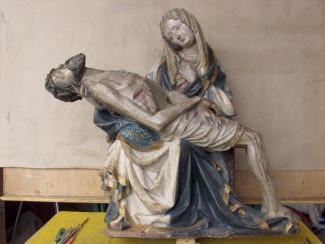
State during the shooting of overpainting on the mantle of the Virgin Mary (2005). Uncovered half white coat with blue backing.
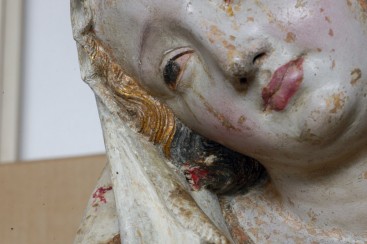
Detail Hair Virgin Mary during the shooting of overpainting, uncovering the original gold leaf gilding (2014).
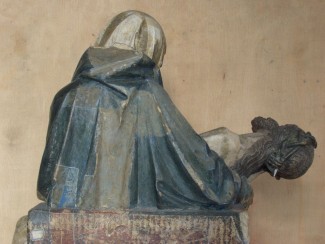
Probes restorer Fratnišek Sysel (1999) supplemented rout repaints the first repaints blue enamel (2005).




